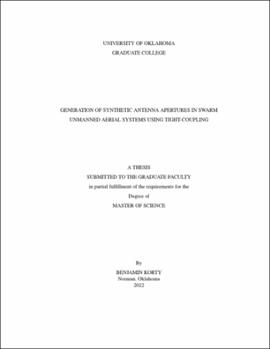| dc.description.abstract | Relative to their various land and air-based counterparts, swarm unmanned aerial system (SUAS) platforms, being comprised of many separate airborne bodies, or elements, possess a number of unique and advantageous characteristics, whether in the context of radar, or communications. These advantages include reduced element complexity, minimal size, weight, and power (SWaP) requirements, and a high degree of redundancy, among others. Because individual bodies in an SUAS are generally smaller than single UAS systems, however, it is generally imperative that the overall electromagnetic performance of the entire swarm match or even exceed that of its single-bodied counterpart, compensating for any reduction in the capabilities of individual radiators within the SUAS. Consequently, even with reduced complexity in the individual elements, the design and control of such large arrays of radiating bodies often presents a very significant challenge. Previous work has demonstrated the efficacy of design techniques involving widely-spaced, sparse arrays, and deliberate use of aperiodicity in order to maximize array radiation performance, while minimizing any deleterious effects. Such design techniques, however, are quite limited in their use, often requiring very large numbers of electromagnetically large elements, whilst only achieving fairly narrowband solutions. Consequently, attempts to make use of these techniques require both a high degree of control complexity, and vast amounts of space, being unable to bring elements close together, lest detrimental phenomena like mutual impedance arise. To enable the design of more tightly-spaced SUAS with fewer, and potentially smaller, elements, a fairly new antenna array design technique will be utilized, being now applied to the more challenging domain of SUAS for the first time. In particular, the following will be the application of tight-coupling, which exploits rather than mitigates the presence of mutual impedance, to closely-spaced antenna arrays. Thus, the ability of tight-coupling techniques, when applied to SUAS, to generate useful antenna array apertures will subsequently investigated. This exploration will pay particular attention to arrays comprised of elements with poor individual radiative capabilities. The performance of these SUAS arrays will be assessed primarily in terms of spectral impedance, efficiency, and realized gain behavior. | en_US |
